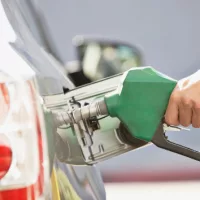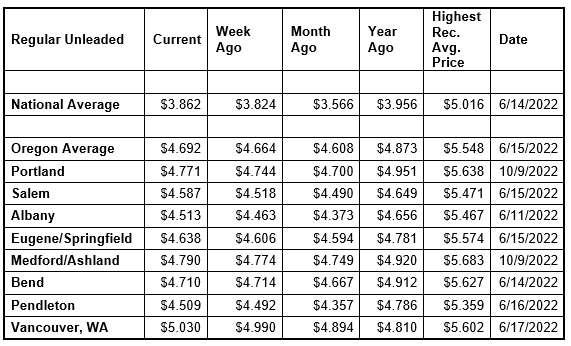
Higher crude oil prices continue to fuel higher pump prices. Gas prices have been inching up since mid-July, after crude oil prices climbed into the upper $70s and low $80s per barrel. In the last month, crude prices have increased 9%. This has pushed the national and Oregon averages to their highest prices since last October. For the week, the national average gains four cents to $3.86. The Oregon average adds three cents to $4.69.

“Crude oil prices are up about 15% since July 1, driven in part by Saudi Arabia’s extension of its production cuts of one million barrels a day through September,” says Marie Dodds, public affairs director for AAA Oregon/Idaho. “Other factors are an increase in demand for gas in the U.S. and a decrease in gasoline supplies.”
Refinery output in the U.S. is back to normal levels. Earlier this summer, extreme heat across much of the U.S. led to refinery outages. When temperatures soar above 100 degrees, refineries can’t operate at peak levels. All refineries in the U.S. are at least 50 years old and many are more than 100 years old. They were not designed to operate in extreme heat. Plus, they’re processing an extremely flammable product.
Crude oil is trading around $81 today compared to $83 a week ago and $89 a year ago. In July, West Texas Intermediate ranged between about $69 and $82 per barrel. In June, WTI ranged between about $67 and $73 per barrel. In May, WTI ranged between about $63 and $77 per barrel. In April, WTI ranged between about $73 and $83. In March, WTI ranged between about $64 and $81 per barrel. In February, WTI ranged between about $73 and $80 per barrel. In January, WTI ranged between about $73 and $82 bbl. Crude reached recent highs of $123.70 on March 8, 2022, shortly after the Russian invasion of Ukraine, and $122.11 per barrel on June 8, 2022. The all-time high for WTI crude oil is $147.27 in July 2008.
Crude oil is the main ingredient in gasoline and diesel, so pump prices are impacted by crude prices on the global markets. On average, about 47% of what we pay for in a gallon of gasoline is for the price of crude oil, 24% is refining, 14% distribution and marketing, and 14% are taxes, according to the U.S. Energy Information Administration.
Demand for gasoline jumped from 8.84 to 9.30 million b/d for the week ending August 4, according to the U.S. Energy Information Administration (EIA). This compares to 9.12 million b/d a year ago. Meanwhile, total domestic gasoline stocks decreased from 219.1 to 216.4 million bbl. Higher demand, amid tighter supply, has helped to keep pump prices elevated. If gas demand remains high, alongside increasing oil prices, drivers should brace for increases in pump prices.
Quick stats
Oregon is one of 31 states and the District of Columbia have higher prices now than a week ago. Ohio (+20 cents) has the largest weekly jump. In all, five states are seeing double-digit increases, compared to three states a week ago. Florida (-9 cents) has the biggest weekly decrease. The average in Louisiana is flat.
California ($5.17) has the most expensive gas in the nation for the third week in a row. Washington ($5.03) is second. These are the only two states with averages at or above $5 a gallon. Hawaii ($4.79) is third, Oregon ($4.69) is fourth, Alaska ($4.48) is fifth, Nevada ($4.42) is sixth, Illinois ($4.17) is seventh, Utah ($4.16) is eighth, Idaho ($4.08) is ninth, Arizona ($4.08) is 10th, the District of Columbia ($4.02) is 11th, Colorado ($4.01) is 12th, and Montana ($4.01) is 13th. These are the 12 states and D.C. with averages at or above $4 a gallon, up from nine states a week ago. This week 38 states have averages in the $3-range. No state has an average in the $2 range this week.
The cheapest gas in the nation is in Mississippi ($3.32) and Louisiana ($3.43). For the 135th week in a row, no state has an average below $2 a gallon.
The difference between the most expensive and least expensive states is $1.85 this week, compared to $1.76 a week ago.
All 50 states and the District of Columbia have higher prices now than a month ago. The national average is 30 cents more and the Oregon average is eight cents more than a month ago. This is the smallest monthly increase in the nation. Oklahoma (+42 cents) has the largest monthly jump.
Oregon is one of 36 states and the District of Columbia with lower prices now than a year ago. The national average is nine cents less and the Oregon average is 18 cents less than a year ago. Idaho (-62 cents) has the largest yearly drop. Washington (+23 cents) has the largest year-over-year increase.
West Coast
The West Coast region continues to have the most expensive pump prices in the nation with all seven states in the top 10. It’s typical for the West Coast to have six or seven states in the top 10 as this region tends to consistently have fairly tight supplies, consuming about as much gasoline as is produced. In addition, this region is located relatively far from parts of the country where oil drilling, production and refining occurs, so transportation costs are higher. And environmental programs in this region add to the cost of production, storage and distribution.















